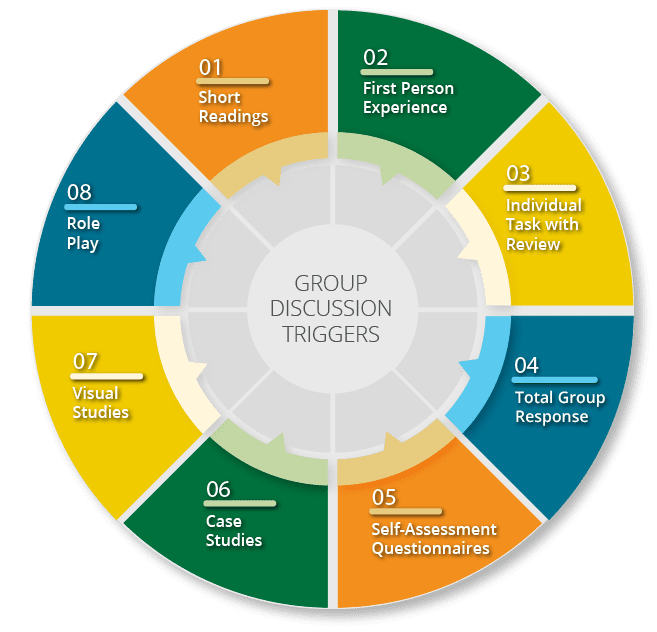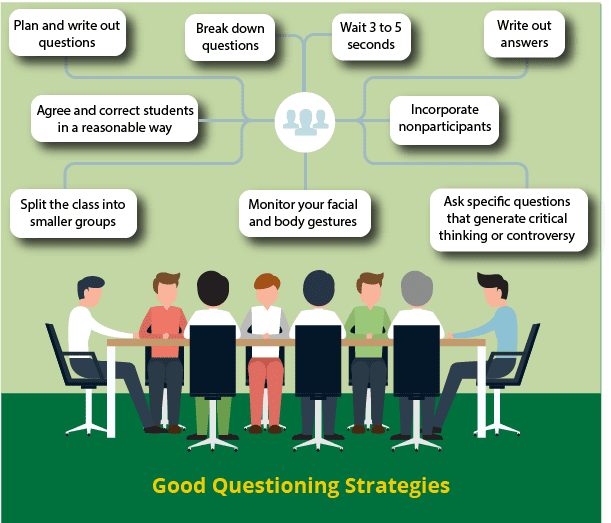Leading Discussions
An effective way to present a common experience is to engage a group in a discussion. Awareness of complexity and enhanced understanding result when learners discuss the meaning of events with each other. But to be successful, groups need a common experience to draw them into participation, establish a personal connection with the content, and provide a shared referent from which to exemplify their ideas. There are many kinds of triggers, but all are designed to precede group discussion. Participants, therefore, become connected with both a concrete example of the content and each other.
Classroom Environment
You can facilitate creating an environment where students feel accepted by other students and have a sense of belonging, by greeting students each day, doing an icebreaker early in the semester, learning their names and talking with them before and after class.
Group Discussion Triggers

- Short Readings: Brief assignments to read in class (especially effective are contrasting viewpoints).
- First Person Experience: Works written in a personal voice, autobiographies, biographies, oral histories, diaries, and memoirs, when used as counterpoints to abstract texts, bridge the gap between their own lives and the content under study. Students more readily take part in discussions when they can personally relate to the material.
- Individual Task with Review: Problems to solve that apply the concepts presented. Students complete a worksheet or other task and compare the results with their neighbors before the whole class discusses the answers.
- Self-assessment Questionnaires: Short surveys of learner attitudes and values.
- Total Group Response: Human Graph: Learners literally take a stand on an imaginary graph or continuum. The first few volunteers justify their choice of position, and then the remainder of the class joins them without comment.
- Case Studies: A case study is the factual account of human experience centered in a problem or issue faced by a person, group or organization. It can raise a variety of complex issues and stimulate discussions of alternative viewpoints. Typically, case studies are written objectively and include a brief overview of the situation, its context, and the major decisions that must be made. Rather than expecting learners to have a right answer, learners develop their ability to articulate their thoughts, frame problems, generate solutions, and evolve principles that may apply to other situations.
- Visual Studies: Seeing first hand creates a common ground. Photographic essays, video programs, and personally made video recordings are examples of ways to bring into the classroom direct depictions of the concepts being discussed.
- Role Play: Learners explore human relations problems by enacting problem situations and then discussing the enactments. Together learners can explore feelings, attitudes, values, and problem solving strategies. It attempts to help individuals find personal meaning within their social world and resolve personal dilemmas with the assistance of the social group
Discussion Starters
(McKeachie and Svinicki, 2014)
- Begin with a common experience such as film clip, cartoon, story, anecdote, personal experience, an excerpt from an assigned reading or demonstration that all your students can relate to.
- Start with a controversy that fits with the material you are teaching and will elicit both viewpoints.
- Opening with a question is a common technique but is effective with careful planning.
Good Questioning Strategies

- Plan and write out the questions to be used in a lesson and use action verbs matched to the student learning desired to develop your questions.
- Break down questions into simpler questions to build a contextual framework to increase student understanding. This technique also brings students back to the more complex question you originally asked if they are unable to answer the first time.
- Wait time of 3 to 5 seconds to increase interaction and enable students to have time to formulate their answer.
- Write out answers: Give students 2 minutes or so to complete a written response, which forces wait time, gives students think-time, and they feel more comfortable answering questions.
- Nonparticipants need to be incorporated. Due to cultural norms, passivity, lack of preparation, boredom or fear of embarrassment, you can help by establishing clear participation expectations during the first day of class. Then create an environment of acceptance and familiarity. Allow students to discuss questions in pairs or small groups. If they feel others share their point of view they may feel freer to answer a question.
- Monitor your facial and body gestures as you answer questions. Appear more approachable by making eye contact, listening attentively, smiling, nodding in approval, move around the room.
- Agree and correct students in a reasonable way so as not to alienate your students and creates a safe environment.. Develop a way of asking and answering questions that is encouraging and respectful.
- Ask specific questions that generate critical thinking and sometimes even controversy or disagreement. If a question has one correct obvious answer (e.g. “… and 2 + 2 is?”), no one is likely to bother answering it.
- Consider splitting the class into smaller groups of 2 to 5 students and giving them a list of questions to answer in their groups. If the discussion seems to have gotten off track, try to bring it back to the original question or point
References
- Center for Teaching Vanderbilt University. (n.d.). Discussions. Retrieved from www.vanderbilt.edu/cft/resources/teaching_resources/activities/discussions.htm
- Williams, G. (2017). Strategies for Encouraging Effective Discussions. The Chronicle of Higher Education. Retrieved from www.chronicle.com/blogs/profhacker/student-discussions/63840
- Eberly Center, Carnegie Mellon University. (n.d.) Discussions. Retrieved from http://www.cmu.edu/teaching/designteach/design/instructionalstrategies/discussions.html
- Bart, M. (2012, July 9). Classroom Discussion: Professors Share Favorite Strategies for Engaging Students. Faculty Focus. Retrieved from www.facultyfocus.com/articles/effective-teaching-strategies/classroom-discussion-professors-share-favorite-strategies-for-engaging-students/
Illustrations by vecteezy.com Infographic vector created by Freepik